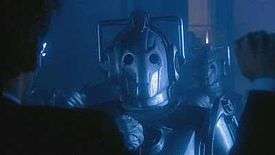
Jakeš
Jakeš is a village in the municipality of Vukosavlje, Republika Srpska, Bosnia and Herzegovina.
References
Jake
Jake may refer to:
See also

Rise of the Cybermen
"Rise of the Cybermen" is the fifth episode of the second series of the British science fiction television programme Doctor Who. The episode introduces a non-extraterrestrial reinvention of the Cybermen, as well as a parallel universe which would serve as a recurring plot element in the series. It is the first part of a two-part story, the concluding part being "The Age of Steel". The TARDIS becomes stranded in an alternative universe where Rose Tyler's father is alive and corporations are closely involved with the British government; one such corporation is Cybus Industries, which is being countered by an underground resistance. The Doctor, Rose and Mickey Smith discover a plot by Cybus co-founder John Lumic to convert the population of London into monotonous cybernetic creatures resembling enemies the Doctor has faced before.
The episode was first broadcast on 13 May 2006. It was directed by Graeme Harper, who became the first and so far only man in the show's history to have directed episodes in both the original and revived runs of the series: he previously directed the acclaimed serial The Caves of Androzani in 1984, and Revelation of the Daleks in 1985.
Coker (surname)
Coker is a surname shared by several notable people, including:
List of people with the surname

Cokernel
In mathematics, the cokernel of a linear mapping of vector spaces f : X → Y is the quotient space Y/im(f) of the codomain of f by the image of f. The dimension of the cokernel is called the corank of f.
Cokernels are dual to the kernels of category theory, hence the name: the kernel is a subobject of the domain (it maps to the domain), while the cokernel is a quotient object of the codomain (it maps from the codomain).
Intuitively, given an equation f(x) = y that one is seeking to solve, the cokernel measures the constraints that y must satisfy for this equation to have a solution – the obstructions to a solution – while the kernel measures the degrees of freedom in a solution, if one exists. This is elaborated in intuition, below.
More generally, the cokernel of a morphism f : X → Y in some category (e.g. a homomorphism between groups or a bounded linear operator between Hilbert spaces) is an object Q and a morphism q : Y → Q such that the composition q f is the zero morphism of the category, and furthermore q is universal with respect to this property. Often the map q is understood, and Q itself is called the cokernel of f.
Podcasts:

